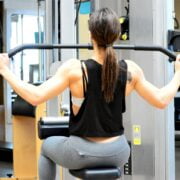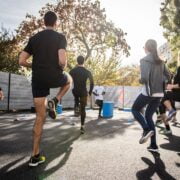
Boost Your Health and Fitness with These Four Types of Exercise
Exercise is an essential component of a healthy lifestyle. It not only helps us maintain a healthy weight, but it also improves our overall physical and mental well-being. There are four main types of exercise that should be incorporated into a well-rounded fitness routine: cardiovascular exercise, strength training, flexibility training, and balance training.
Cardiovascular exercise, also known as aerobic exercise, is any activity that increases your heart rate and gets your blood pumping. This type of exercise is essential for maintaining a healthy heart and reducing the risk of chronic diseases such as heart disease, diabetes, and certain types of cancer. It also aids in weight loss by burning calories and increasing your metabolism.
Strength training, on the other hand, focuses on building muscle and increasing strength. This type of exercise involves using resistance, such as weights or resistance bands, to challenge your muscles. Strength training not only helps you build lean muscle mass, but it also helps you burn fat and improve bone density. It is especially important as we age to prevent muscle loss and maintain a strong body.
Flexibility training, often overlooked in fitness routines, is crucial for maintaining good range of motion in our joints and preventing injuries. This type of exercise involves stretching and lengthening our muscles to improve flexibility. Flexibility training can help reduce muscle soreness after workouts, improve posture, and aid in relaxation.
Lastly, balance training is important for improving stability and preventing falls, especially as we age. This type of exercise involves exercises that challenge your balance, such as standing on one leg or using a balance board. Balance training can help improve coordination and proprioception (the ability to sense the position of your body in space), which can reduce the risk of falls and injuries.
Key Takeaways
- There are four types of exercise: cardiovascular, strength training, flexibility training, and balance training.
- Cardiovascular exercise is essential for heart health and can improve endurance and stamina.
- Strength training helps build muscle and burn fat, leading to a leaner and stronger body.
- Flexibility training through stretching can improve range of motion and prevent injury.
- Balance training can improve stability and prevent falls, especially in older adults.
Cardiovascular Exercise: Why It’s Essential for Your Health
Cardiovascular exercise is any activity that increases your heart rate and gets your blood pumping. This type of exercise is essential for maintaining a healthy heart and reducing the risk of chronic diseases. When you engage in cardiovascular exercise, your heart works harder to pump oxygen-rich blood to your muscles, which strengthens your heart muscle and improves its efficiency.
Regular cardiovascular exercise has been shown to reduce the risk of heart disease, high blood pressure, stroke, and diabetes. It can also help lower cholesterol levels and improve blood sugar control. Additionally, cardiovascular exercise aids in weight loss by burning calories and increasing your metabolism. It is an effective way to burn fat and maintain a healthy weight.
To incorporate cardiovascular exercise into your routine, you can engage in activities such as running, swimming, cycling, dancing, or brisk walking. Aim for at least 150 minutes of moderate-intensity aerobic activity or 75 minutes of vigorous-intensity aerobic activity per week. You can break this up into smaller sessions throughout the week if needed. Remember to start slowly and gradually increase the intensity and duration of your workouts to avoid injury.
Strength Training: Building Muscle and Burning Fat
Strength training is an important component of a well-rounded fitness routine. It involves using resistance, such as weights or resistance bands, to challenge your muscles and increase their strength. Strength training not only helps you build lean muscle mass, but it also helps you burn fat and improve bone density.
When you engage in strength training exercises, you create microscopic tears in your muscle fibers. As these tears heal, your muscles become stronger and more defined. Building muscle is important for several reasons. Firstly, it increases your metabolism, which means you burn more calories even at rest. This can aid in weight loss and weight maintenance. Secondly, it improves bone density, which is especially important as we age to prevent osteoporosis and fractures.
To incorporate strength training into your routine, aim for at least two days per week of strength training exercises that target all major muscle groups. This can include exercises such as squats, lunges, push-ups, and bicep curls. Start with lighter weights or resistance bands and gradually increase the weight or resistance as you get stronger. Remember to allow your muscles time to recover between strength training sessions to avoid overtraining.
Flexibility Training: The Benefits of Stretching
| Benefits of Flexibility Training |
|---|
| Improved range of motion |
| Reduced risk of injury |
| Improved posture |
| Reduced muscle tension and soreness |
| Improved athletic performance |
| Improved blood flow and circulation |
| Reduced stress and anxiety |
| Improved balance and coordination |
Flexibility training is often overlooked in fitness routines, but it is crucial for maintaining good range of motion in our joints and preventing injuries. This type of exercise involves stretching and lengthening our muscles to improve flexibility. Flexibility training can help reduce muscle soreness after workouts, improve posture, and aid in relaxation.
When you engage in flexibility training exercises, you stretch your muscles and tendons, which helps improve their elasticity. This allows for greater range of motion in your joints and can help prevent muscle imbalances and injuries. Stretching also increases blood flow to your muscles, which can help reduce muscle soreness and promote recovery after workouts.
To incorporate flexibility training into your routine, aim for at least two days per week of stretching exercises that target all major muscle groups. This can include static stretches, where you hold a stretch for a certain amount of time, or dynamic stretches, where you move through a range of motion. Remember to warm up your muscles before stretching by engaging in light cardiovascular exercise, such as jogging or jumping jacks.
Balance Training: Improving Stability and Preventing Falls
Balance training is an important component of a well-rounded fitness routine, especially as we age. It involves exercises that challenge your balance and proprioception (the ability to sense the position of your body in space). Balance training can help improve stability, reduce the risk of falls, and aid in injury prevention.
As we age, our balance naturally declines, which can increase the risk of falls and injuries. Engaging in balance training exercises can help improve coordination and proprioception, which can reduce the risk of falls. Balance training also strengthens the muscles in your legs and core, which are important for maintaining stability and good posture.
To incorporate balance training into your routine, you can engage in exercises such as standing on one leg, heel-to-toe walk, or using a balance board. Aim for at least two days per week of balance training exercises. Start with exercises that challenge your balance but are still manageable, and gradually increase the difficulty as you get stronger and more stable.
How to Incorporate All Four Types of Exercise into Your Routine
To create a well-rounded exercise routine that includes all four types of exercise, it is important to find a balance between cardiovascular exercise, strength training, flexibility training, and balance training. Here are some tips to help you incorporate all four types of exercise into your routine:
1. Schedule your workouts: Set aside specific times during the week for each type of exercise. This will help you stay consistent and ensure that you are getting a variety of workouts.
2. Mix it up: Don’t be afraid to try new activities and mix up your workouts. This will keep things interesting and prevent boredom.
3. Start slow: If you are new to exercise or have been inactive for a while, start with shorter workouts and gradually increase the duration and intensity as you get stronger.
4. Listen to your body: Pay attention to how your body feels during and after each workout. If something doesn’t feel right or causes pain, modify or stop the exercise.
5. Seek guidance: If you are unsure about how to incorporate all four types of exercise into your routine, consider working with a personal trainer or fitness professional who can help create a customized plan for you.
Remember that everyone’s fitness needs and goals are different, so it is important to listen to your body and do what feels right for you. Don’t compare yourself to others or feel pressured to do more than you are comfortable with. The most important thing is to find activities that you enjoy and that make you feel good.
The Importance of Consistency in Your Exercise Plan
Consistency is key when it comes to seeing results from exercise. It is important to stick to your exercise plan and make it a regular part of your routine. Here’s why consistency is important:
1. Progress: Consistently engaging in exercise allows you to make progress and see improvements in your fitness level. If you only exercise sporadically, you won’t see the same results as someone who exercises consistently.
2. Habit formation: Consistency helps you form healthy habits. When you make exercise a regular part of your routine, it becomes easier to stick to and becomes a habit.
3. Mental health benefits: Regular exercise has been shown to improve mental health and reduce symptoms of anxiety and depression. Consistently engaging in exercise can help improve your mood and overall well-being.
To stay consistent with your exercise routine, try the following tips:
1. Set realistic goals: Set goals that are achievable and realistic for your lifestyle. This will help keep you motivated and prevent burnout.
2. Find activities you enjoy: Choose activities that you enjoy and look forward to doing. This will make it easier to stick to your routine.
3. Make it a priority: Schedule your workouts like you would any other appointment or commitment. Treat exercise as a non-negotiable part of your day.
4. Find an accountability partner: Find a workout buddy or join a fitness class where you can hold each other accountable and motivate each other to stay consistent.
5. Track your progress: Keep track of your workouts and progress to see how far you’ve come. This can be motivating and help you stay on track.
Remember that consistency doesn’t mean you have to work out every single day without fail. It means finding a routine that works for you and sticking to it as best as you can. Life happens, and there will be days when you can’t fit in a workout. The important thing is to get back on track as soon as possible and not let one missed workout derail your progress.
Tips for Staying Motivated and Overcoming Exercise Plateaus
Staying motivated to exercise can be challenging, especially when you hit a plateau or feel like you’re not making progress. Here are some tips to help you stay motivated and overcome exercise plateaus:
1. Set new goals: If you’ve reached a plateau, it may be time to set new goals. This could be increasing the intensity or duration of your workouts, trying a new activity, or working towards a specific event or race.
2. Change up your routine: If you’re feeling bored or unmotivated, try changing up your routine. This could mean trying new exercises, taking a different fitness class, or exploring outdoor activities.
3. Find a workout buddy: Exercising with a friend or joining a fitness class can help keep you motivated and accountable. Having someone to share your workouts with can make them more enjoyable and help you stay on track.
4. Reward yourself: Set small rewards for reaching milestones or sticking to your exercise routine. This could be treating yourself to a massage, buying new workout gear, or enjoying a favorite healthy meal.
5. Track your progress: Keep track of your workouts and progress to see how far you’ve come. This can be motivating and help you stay focused on your goals.
6. Take rest days: Rest days are just as important as exercise days. Give your body time to recover and rest so that you can avoid burnout and prevent injuries.
Remember that progress takes time and there will be ups and downs along the way. Stay patient and trust the process. Celebrate small victories and focus on how exercise makes you feel, both physically and mentally.
Proper Nutrition to Support Your Fitness Goals
Proper nutrition is an important component of supporting your fitness goals. Eating a balanced diet that provides your body with the nutrients it needs can help fuel your workouts, aid in recovery, and support overall health. Here are some tips for eating a balanced diet that supports your exercise routine:
1. Eat a variety of foods: Aim to include a variety of fruits, vegetables, whole grains, lean proteins, and healthy fats in your diet. This will ensure that you are getting a wide range of nutrients.
2. Stay hydrated: Drink plenty of water throughout the day to stay hydrated. Water is essential for regulating body temperature, lubricating joints, and transporting nutrients.
3. Fuel your workouts: Eat a balanced meal or snack before and after your workouts to provide your body with the energy it needs. Include carbohydrates for energy, protein for muscle repair and growth, and healthy fats for satiety.
4. Listen to your body: Pay attention to how different foods make you feel. Everyone’s nutritional needs are different, so it’s important to listen to your body and eat foods that make you feel good.
5. Practice portion control: Be mindful of portion sizes and listen to your body’s hunger and fullness cues. Eating until you are satisfied, not stuffed, can help prevent overeating.
6. Seek professional guidance: If you’re unsure about how to eat a balanced diet that supports your exercise routine, consider working with a registered dietitian or nutritionist who can provide personalized guidance.
Remember that nutrition is not about restriction or deprivation. It’s about nourishing your body with the nutrients it needs to function optimally. Focus on eating whole, unprocessed foods as much as possible and find a balance that works for you.
The Long-Term Benefits of Regular Exercise for Your Health and Well-Being
Regular exercise has numerous long-term benefits for your health and well-being. Here are some of the key benefits:
1. Improved physical health: Regular exercise can help improve cardiovascular health, lower blood pressure, reduce the risk of chronic diseases such as heart disease and diabetes, and improve bone density.
2. Weight management: Regular exercise, combined with a balanced diet, can help you maintain a healthy weight or lose weight if needed. It increases your metabolism and helps burn calories.
3. Mental health benefits: Exercise has been shown to improve mental health and reduce symptoms of anxiety and depression. It can boost your mood, reduce stress, and improve sleep quality.
4. Increased longevity: Regular exercise has been linked to increased longevity. It can help prevent age-related diseases and improve overall quality of life as you age.
5. Improved cognitive function: Exercise has been shown to improve cognitive function and memory. It can enhance focus, attention, and problem-solving skills.
6. Increased energy levels: Regular exercise can boost your energy levels and reduce feelings of fatigue. It improves circulation and oxygen flow to your muscles, which can increase energy levels.
7. Better sleep quality: Exercise can help improve sleep quality by reducing stress and anxiety, promoting relaxation, and regulating sleep-wake cycles.
8. Enhanced self-confidence: Regular exercise can boost self-confidence and self-esteem. Achieving fitness goals and seeing improvements in your physical abilities can increase feelings of self-worth.
Incorporating regular exercise into your lifestyle is one of the best investments you can make for your health and well-being. Remember that it’s never too late to start. Whether you’re in your 20s or your 60s, engaging in physical activity can have numerous benefits. Regular exercise can help improve cardiovascular health, strengthen muscles and bones, boost mood and mental well-being, and even reduce the risk of chronic diseases such as diabetes and certain types of cancer. It can also help with weight management and improve overall quality of life. So don’t wait any longer – start incorporating exercise into your daily routine and reap the rewards for years to come.
If you’re interested in exploring more ways to improve your health and physical well-being, you might find this article on Wave Magnets intriguing. They discuss the benefits of using magnetic therapy for pain relief and overall wellness. Magnetic therapy has gained popularity as a non-invasive and drug-free approach to managing various health conditions. By incorporating magnetic therapy into your exercise routine, you can potentially enhance the benefits of the four types of exercises mentioned in the previous article. Check out this article to learn more about the potential benefits of magnetic therapy in improving your overall health and well-being.
FAQs
What are the four types of exercise?
The four types of exercise are aerobic, strength, balance, and flexibility.
What is aerobic exercise?
Aerobic exercise is any activity that increases your heart rate and breathing, such as running, cycling, or swimming.
What is strength exercise?
Strength exercise is any activity that builds muscle strength and endurance, such as weightlifting or resistance training.
What is balance exercise?
Balance exercise is any activity that improves your ability to maintain your balance, such as yoga or tai chi.
What is flexibility exercise?
Flexibility exercise is any activity that improves your range of motion and flexibility, such as stretching or yoga.
What are the benefits of aerobic exercise?
Aerobic exercise can improve cardiovascular health, increase endurance, and help with weight management.
What are the benefits of strength exercise?
Strength exercise can improve muscle strength and endurance, increase bone density, and help with weight management.
What are the benefits of balance exercise?
Balance exercise can improve stability and reduce the risk of falls, especially in older adults.
What are the benefits of flexibility exercise?
Flexibility exercise can improve range of motion, reduce the risk of injury, and improve posture and balance.

















